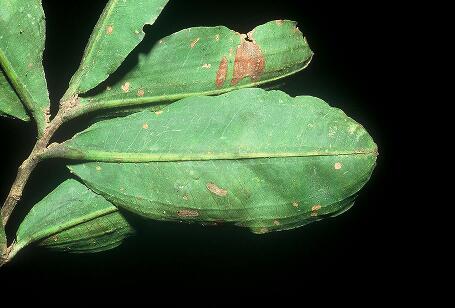Lecythidaceae
Couratari macrosperma A. C. Sm.

Kingdom: Plantae Rank: Species Parent: Couratari Status: Valid
Common Names:
- Misa colorado, pancho - Spanish, Peru
- Tauari - Portuguese, Brazil
Taxonomic Classification
Classification: Morphological diagnosis same as for the genus. This species is closely related to Couratari stellata which has a more easterly Amazonian distribution.
Morphological Description
Diagnosis: Leaves with longitudinal striations; flowers with an echinate hood with an external flap; large, cylindrical fruits, and seeds with a circumferential wing.
Vegetative Morphology
Habit: Trees, canopy to emergent, to 50 m tall. Trunks buttressed or scarcely buttressed.
Leaves: Leaves with petioles 5-12 mm long; blades 8-21 x 2.5-9 cm, oblong to oblong-lanceolate, nearly glabrous, with a few stellate trichomes abaxially, with several longitudinal lines parallel to midrib; domatia absent; base obtuse to cuneate; margins entire but slightly undulate; apex acute to shortly acuminate; secondary veins in (13)16-21(27) pairs.
Reproductive Morphology
Inflorescence: Inflorescences terminal and axillary, racemes, the rachises densely stellate pubescent, ferruginous; pedicels articulate, 2-6 mm long below and 1-4 mm long above articulation.
Flowers: Flowers with leaves present, the flowers ca. 5 cm diam.; hypathium densely, stellate pubescent, ferruginous; petals nearly as long as wide, white or pale yellow; androecial hood with echinate external flap, pale yellow.
Fruit: Fruits dehiscent, 12-15 x 7 cm, cylindrical.
Other
Uses: There are no documented uses of this species.
Distribution: Southwestern and central Amazonia south of the Amazon River and in the coastal forests of eastern Brazil. See distribution map Fig. 50 in Prance (1990).
Ecology: Grows in terra firme forests.
Chromosome Number: Not known.
Notes: Amazonian flowering collections come from February and May through November. A collection with seed has been made in Peru in November and another with nearly mature seeds in July at Los Amigos.There have been no pollination studies of this species but the flowers are most likely pollinated by bees. The winged seeds are dispersed by the wind. Scarlet macaws have been observed opening the fruits to eat the seeds of C. macrosperma at Los Amigos.
Typification
Type Citation: Bull. Torrey Bot. Club 60: 383. 1933.
Basionym: Not applicable.
Basionym Citation: Not applicable.
Type Locality: Brazil. Rondônia: Tabajara, Rio Machado region.
Type Collection: Krukoff 1513
Types Deposited at: Holotype: NY; Isotypes: A, BM, F, G, K,. MICH, MO, P, S, U, US, WIS
Other Published Figures: Prance, Fl. Neotrop. Monogr. 21(II): Fig. 49D (1990). – Fr only.